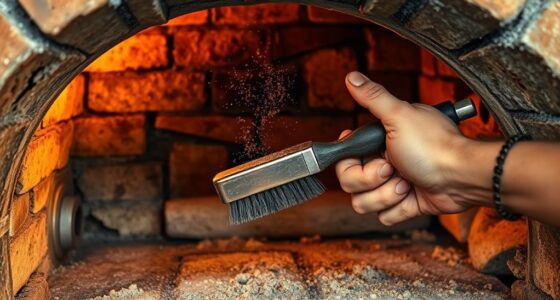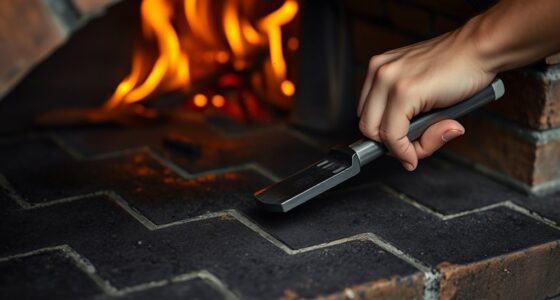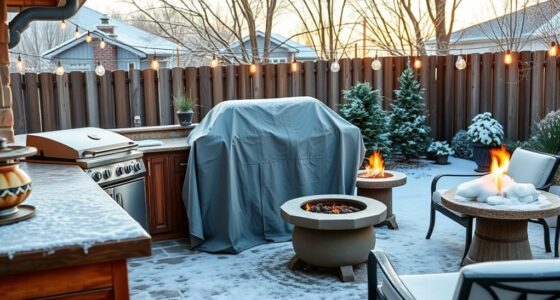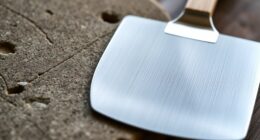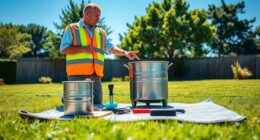To quickly winterize your outdoor kitchen in a weekend, start by inspecting and cleaning all surfaces, appliances, and fixtures thoroughly; cover and protect your grill and outdoor equipment with weather-resistant covers. Drain plumbing lines to prevent freezing damage and seal gaps in cabinets and storage areas with insulation or caulk. Finally, cover furniture and electrical components to shield them from snow and ice. Keep following these steps, and you’ll guarantee your outdoor space stays protected all winter long.
Key Takeaways
- Conduct a thorough inspection of all outdoor appliances, fixtures, and electrical systems, and address any damage or corrosion.
- Drain and winterize plumbing lines with antifreeze and blow out residual water to prevent freezing damage.
- Clean surfaces, cover appliances with weatherproof covers, and store cushions and delicate accessories indoors.
- Seal gaps around cabinetry and electrical outlets, insulate exposed areas, and ensure all protective covers are secure.
- Perform final checks for leaks, damage, and proper sealing before covering or storing all outdoor kitchen components.
Assess Your Outdoor Kitchen and Gather Supplies

Before you begin winterizing your outdoor kitchen, evaluating the space and gathering all necessary supplies is vital. Start by inspecting your outdoor lighting to guarantee it’s functional and protected from the elements. Proper lighting not only enhances safety but also helps you see clearly during winter preparations. Next, consider pest prevention; clear away debris and seal gaps to keep pests out during the off-season. Gather weatherproof covers, insulation materials, and cleaning supplies to protect appliances and surfaces. Check for any damaged wiring or fixtures that need repair. Having all these items ready simplifies the winterizing process and prevents surprises. Additionally, understanding the importance of material choice in protecting surfaces can help ensure your outdoor kitchen remains durable through harsh weather conditions. Taking these initial steps ensures your outdoor kitchen remains safe, protected, and ready for use when warmer weather returns.
Clean and Deep-Treat Cooking Surfaces and Appliances
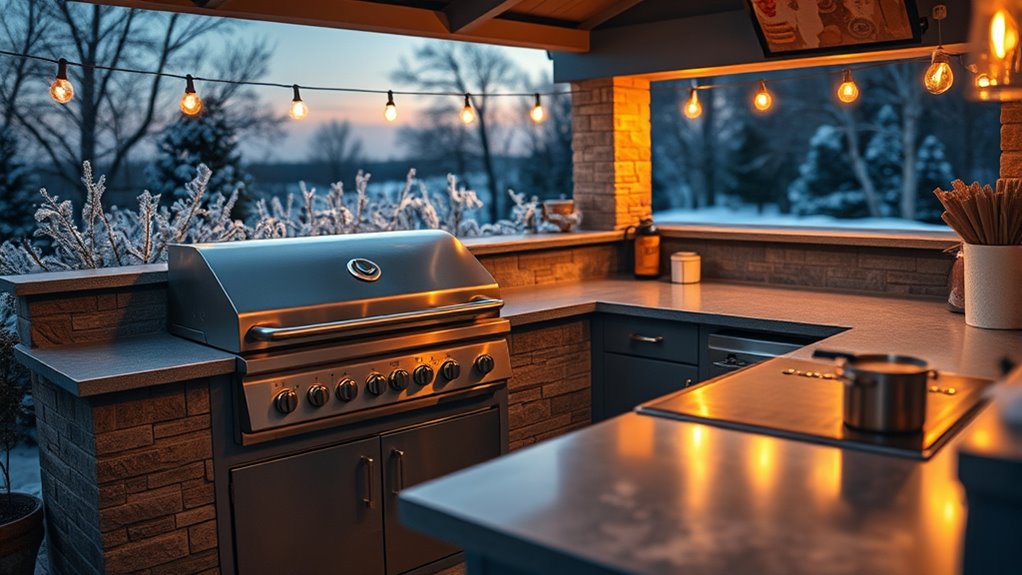
Start by scrubbing your cooking surfaces to remove any food residues and buildup. Next, sanitize all appliances to prevent bacteria and mold from developing during the winter months. Finally, protect and cover your equipment to keep it safe from the elements and damage. Incorporating data privacy considerations into your preparations can help ensure that any digital or smart appliances remain secure during the off-season.
Scrub and Remove Residues
Have you ever noticed how stubborn grease and food residues can cling to your outdoor kitchen surfaces? To prepare for winter, you need to scrub thoroughly and remove residues that can cause damage over time. Focus on removing grease by using a degreasing cleaner or a mixture of vinegar and baking soda. This helps eliminate stains and buildup that might attract pests or cause corrosion. Use a scrub brush or sponge to work the cleaner into all nooks and crannies. Pay special attention to grills, burners, and countertops. Rinse everything well with water afterward to remove loosened grime. Proper scrubbing ensures your surfaces are clean, residue-free, and ready for the colder months, preventing long-term damage and making your winterizing process more effective.
Sanitize All Surfaces
Wondering how to guarantee your outdoor kitchen stays safe and hygienic during winter? Start by thoroughly sanitizing all surfaces and appliances. Use a food-safe disinfectant to wipe down countertops, grills, and sinks, ensuring any leftover residue or bacteria are eliminated. This helps prevent pests and mold from taking hold during the off-season. While doing this, consider outdoor pest control measures to keep critters away. Additionally, take the opportunity for seasonal decor updates, removing any items that could trap moisture or pests. Deep cleaning now minimizes the risk of mold growth or lingering odors once you reopen in spring. Proper sanitation ensures your outdoor kitchen remains in top shape, ready for use when warmer weather returns. Vetted – Halloween Product Reviews
Protect and Cover Equipment
To guarantee your outdoor kitchen remains in prime condition through winter, it is vital to safeguard and cover your equipment properly. Clean and deep-treat your cooking surfaces and appliances to prevent rust and damage. Use weatherproof appliances or cover equipment securely with waterproof covers to shield against snow and moisture. Properly covering your equipment minimizes exposure to the elements, extending its lifespan. Additionally, ensure your covers are compatible with your headphones to prevent damage from moisture or debris during storage.
Protect and Cover Your Grill and Other Equipment

Before winter arrives, it’s essential to safeguard your grill and other outdoor kitchen equipment from the harsh elements. Start by covering outdoor vents to prevent moisture buildup and debris from causing damage. Ensure all vents are securely covered with weatherproof covers. Wrap propane tanks with a protective cover or store them in a safe, sheltered location away from the elements. This prevents rust and corrosion, extending the tank’s lifespan. Remove any propane tanks if possible, or ensure they’re tightly sealed and stored upright. Additionally, cover your grill with a sturdy, weather-resistant cover to keep off snow, rain, and ice. Properly covering and protecting your equipment now will make spring setup easier and help preserve your outdoor kitchen’s condition all winter long. For added protection, consider skincare tips for outdoor elements to maintain your equipment’s longevity and appearance.
Drain and Winterize Plumbing and Water Lines
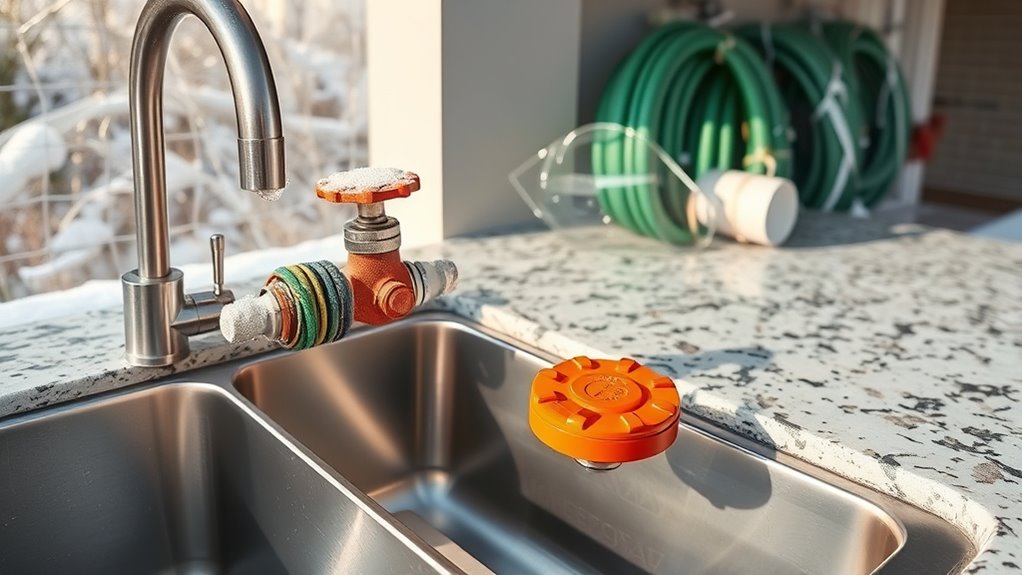
As winter approaches, it’s essential to drain and winterize your outdoor plumbing and water lines to prevent freezing and damage. Proper drain maintenance guarantees water doesn’t expand inside pipes, causing cracks or bursts. To protect your water lines effectively, follow these steps:
Prepare your outdoor plumbing for winter to prevent freezing and costly damage.
- Turn off the main water supply to the outdoor lines.
- Open faucets and drain valves to release remaining water.
- Use compressed air or a shop vacuum to blow out residual water.
- Add antifreeze if necessary for extra water line protection.
- Regular prenatal check-ups are essential during pregnancy to monitor fetal development and ensure maternal health.
These actions help prevent costly repairs and keep your outdoor kitchen in top shape through winter. Don’t skip drain maintenance, as it’s key to avoiding frozen pipes and water line damage come spring.
Seal and Insulate Cabinets and Storage Areas

Have you considered how exposed cabinets and storage areas can lose heat and become vulnerable to the cold? Proper cabinet insulation and storage sealing are essential for winterizing your outdoor kitchen. Insulate gaps around doors and panels with weatherproof foam or caulk to prevent drafts. Use weather-resistant seals to close gaps around cabinet edges and hinges. Adding foam board insulation inside cabinets helps maintain internal temperature, protecting your equipment. For storage areas, seal all openings to keep cold air out and moisture in check. Recognizing these signs of energy loss can help you take effective measures to preserve your outdoor kitchen during winter.
Cover Furniture and Decor to Prevent Damage
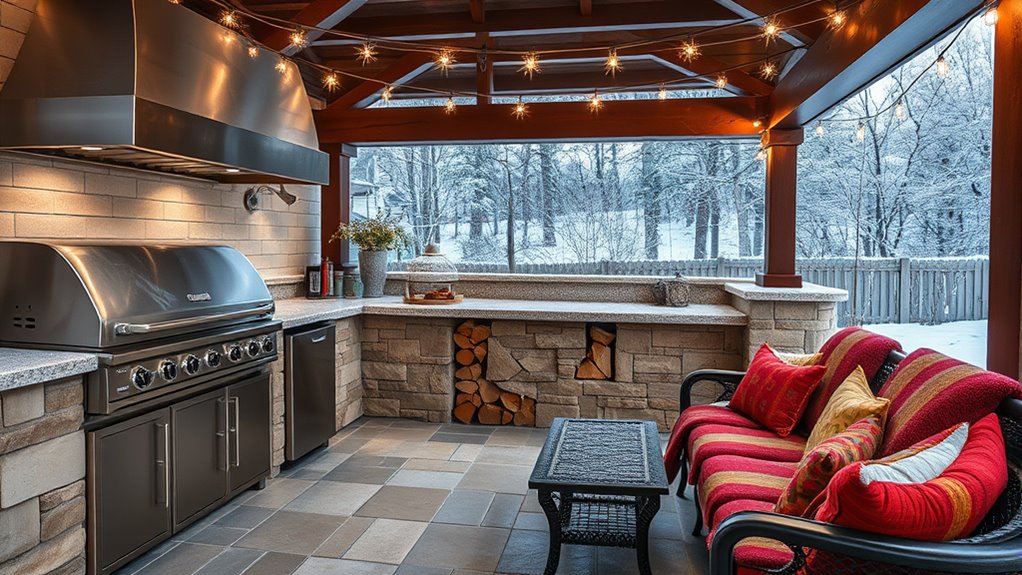
To safeguard your outdoor furniture and decor, use sturdy covers that fit well and shield against snow and moisture. Store cushions indoors to prevent mold and damage, and consider adding weatherproof accessories like covers or sealants. These steps ensure your outdoor space stays in good shape through the winter months. Incorporating weatherproofing techniques can further protect your investments from harsh winter elements.
Use Protective Covers Effectively
Protecting your outdoor furniture and decor with sturdy covers is essential to prevent damage during winter. Proper use of protective covers keeps your outdoor furniture safe from snow, ice, and moisture. To do this effectively:
- Ensure covers fit snugly to prevent wind from displacing them.
- Choose waterproof, breathable protective covers to avoid mold and mildew.
- Clean your outdoor furniture before covering to remove dirt and debris.
- Secure covers tightly at the bottom to prevent snow buildup and water leakage.
- Selecting covers made from sustainable and eco-friendly materials aligns with increasing consumer demand for sustainable products in the market.
Store Cushions Indoors
Storing cushions indoors is a simple yet effective way to prevent damage from winter weather. Proper cushion storage keeps your outdoor furniture looking fresh and extends its lifespan. Remove cushions from furniture and place them in a dry, well-ventilated space. Using indoor insulation around the cushions helps protect them from moisture and temperature fluctuations. If possible, store cushions in plastic bins or storage bags to keep out humidity and pests. Make sure cushions are completely dry before bringing them inside to prevent mold. Regularly inspect your indoor storage area to ensure it remains dry and free of pests. Incorporating weather-resistant materials into your outdoor cushions can also help prolong their durability throughout winter months. By taking these steps, you’ll keep your outdoor cushions in top condition, ready for use when warmer weather returns.
Add Weatherproof Accessories
Adding weatherproof accessories is essential for shielding your outdoor furniture and decor from winter damage. Proper outdoor protection guarantees your items stay in good condition through harsh weather. Consider these steps:
- Cover furniture with waterproof covers to prevent moisture buildup.
- Use weatherproof cushions or store them indoors to avoid mold and rot.
- Wrap decorative pieces with protective wraps or store them safely inside.
- Install weatherproof lighting fixtures to endure cold and moisture.
These accessories create a barrier against snow, rain, and ice, maintaining your outdoor kitchen’s appeal. By investing in weatherproof accessories, you prolong the life of your outdoor furniture and decor, ensuring they’re ready for use when warmer weather returns. Outdoor protection is key to hassle-free winterizing.
Check and Maintain Electrical Systems and Lighting
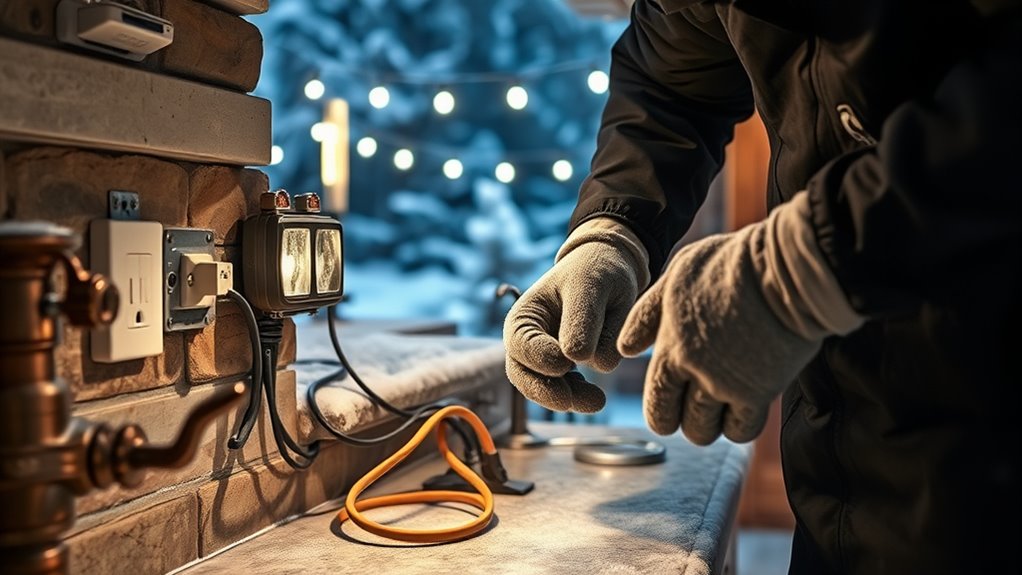
Before winter sets in, ensuring proper inspection and upkeep of your outdoor kitchen’s electrical systems and lighting is vital. Start by checking all outdoor electrical connections for signs of wear, corrosion, or damage. Make sure outlets and switches are functioning properly and are weatherproofed to prevent moisture intrusion. Conduct lighting maintenance by testing all fixtures, replacing burnt-out bulbs, and sealing any gaps around fixtures to keep moisture out. Inspect wiring for frays or exposed areas and repair or replace as needed. Turn off power to outdoor outlets and lighting before winter storms arrive to prevent electrical hazards. Properly maintaining your outdoor electrical system ensures safety and keeps everything ready for easy use when warmer weather returns.
Final Inspection and Seasonal Storage Tips

As winter approaches, taking a final walkthrough to inspect your outdoor kitchen guarantees everything is in top shape for the season’s end. Perform a thorough final inspection, checking for damage or leaks, and ensure all appliances are clean and dry. For seasonal storage, follow these steps:
Perform a final inspection and prepare your outdoor kitchen for winter storage to ensure longevity and readiness for spring.
- Remove and clean all removable parts, like grates and burners.
- Cover appliances with weatherproof covers to prevent debris buildup.
- Store utensils, cookware, and small accessories in sealed containers.
- Drain and disconnect any water lines or hoses to prevent freezing.
This final inspection and proper seasonal storage protect your outdoor kitchen from harsh weather, extending its lifespan. Taking these simple steps ensures your setup remains ready for spring, avoiding costly repairs or replacements.
Frequently Asked Questions
How Do I Prevent Pests From Accessing My Outdoor Kitchen During Winter?
To prevent pests from accessing your outdoor kitchen during winter, start with a pest deterrent like sealing gaps and cracks around doors, windows, and vents. Use wildlife exclusion techniques such as installing mesh screens over vents and openings. Keep the area clean and store food securely. Regularly inspect for signs of pests, and consider using natural repellents. These steps will help protect your outdoor kitchen from unwanted guests all season long.
What Are the Best Methods for Insulating Outdoor Kitchen Cabinets?
Think your outdoor kitchen’s insulation is as simple as wrapping it in bubble wrap? Think again! The best methods involve using high-quality insulation materials like foam board or spray foam, which trap heat effectively. Don’t forget cabinet sealing to prevent drafts and moisture intrusion. Proper insulation materials and tight cabinet sealing keep your kitchen warm and ready for winter, ensuring your culinary adventures don’t freeze over.
How Can I Winterize Outdoor Countertops to Avoid Cracking or Damage?
To winterize your outdoor countertops and prevent cracking or damage, you should use covering techniques like waterproof tarps or custom-fit protective covers to shield surfaces from moisture and freezing temperatures. Additionally, apply a sealant suitable for your countertop material to protect surfaces from ice and cold. Make sure to remove any debris and clean thoroughly before covering, ensuring maximum protection and longevity throughout the winter months.
What Safety Precautions Should I Take When Working With Electrical Systems Outdoors?
You never want to take electrical safety lightly outdoors. Before starting, turn off power at the breaker to prevent shocks. Use weatherproof wiring and outdoor-rated outlets to avoid shorts or fires. Keep electrical connections away from water and moisture, and always wear insulated gloves. Check your equipment regularly for damage, and use GFCI outlets for added protection. Don’t rush—your safety depends on careful, deliberate steps.
How Do I Store Small Appliances for Winter to Prolong Their Lifespan?
To prolong your small appliances’ lifespan, focus on proper appliance storage and winter protection. Clean and dry each item thoroughly before storing them in a cool, dry place away from direct sunlight. Use protective covers or storage bins to shield appliances from dust and moisture. Avoid storing them in unheated areas susceptible to freezing temperatures, as this can damage internal components. Proper storage guarantees your appliances stay functional and ready for use next season.
Conclusion
So, you’ve mastered winterizing your outdoor kitchen in a weekend—congratulations! Now you can sit back, sip your hot cocoa, and pretend it’s all just a big, cozy winter hug for your appliances. Who knew protecting your investment could be so satisfying? Just remember, if you forget anything, Mother Nature’s got a funny way of reminding you—usually with a snowstorm. But hey, you’re ready. Winter-proofed and fabulous—what’s next?


